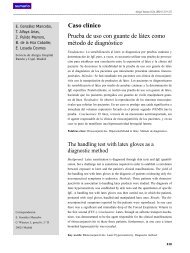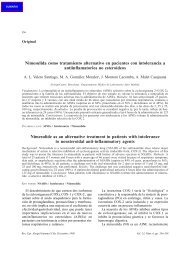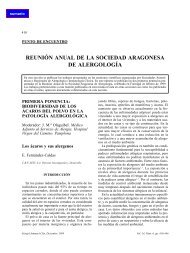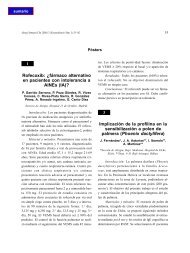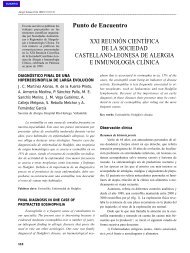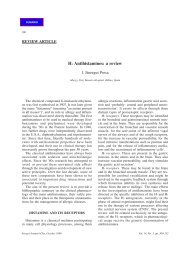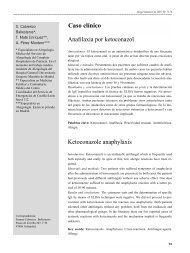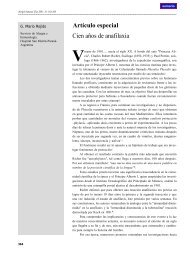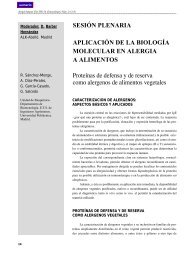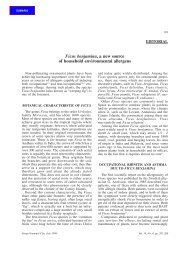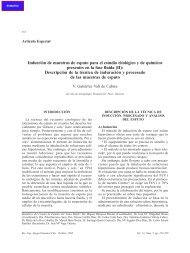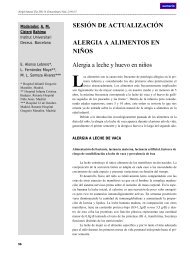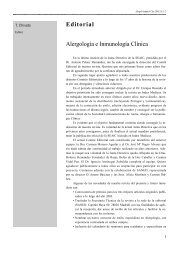Prevalencia de la sensibilización a Anisakis simplex en tres áreas ...
Prevalencia de la sensibilización a Anisakis simplex en tres áreas ...
Prevalencia de la sensibilización a Anisakis simplex en tres áreas ...
Create successful ePaper yourself
Turn your PDF publications into a flip-book with our unique Google optimized e-Paper software.
L. Fernán<strong>de</strong>z <strong>de</strong> Corres, et al<br />
fue dividida <strong>en</strong> <strong>tres</strong> <strong>áreas</strong> según su consumo <strong>de</strong> pescado.<br />
Criterio <strong>de</strong> <strong>s<strong>en</strong>sibilización</strong>: prick-test positivo o anticuerpos<br />
IgE específicos a <strong>Anisakis</strong> <strong>simplex</strong>; Criterio<br />
<strong>de</strong> alergia: Urticaria/angioe<strong>de</strong>ma tras <strong>la</strong> ingesta <strong>de</strong> pescado,<br />
<strong>s<strong>en</strong>sibilización</strong> a <strong>Anisakis</strong> <strong>simplex</strong> y exclusión <strong>de</strong><br />
<strong>la</strong> <strong>s<strong>en</strong>sibilización</strong> a pescado.<br />
Resultados: La preval<strong>en</strong>cia <strong>de</strong> <strong>s<strong>en</strong>sibilización</strong> fue <strong>de</strong><br />
38,1% <strong>en</strong> el grupo U y 13,1% <strong>en</strong> el grupo NU. El riesgo<br />
<strong>de</strong> <strong>s<strong>en</strong>sibilización</strong> aum<strong>en</strong>ta con <strong>la</strong> edad, <strong>la</strong> ingesta<br />
<strong>de</strong> pescado no cocinado y los títulos elevados <strong>de</strong> IgE<br />
total. El 19,2% <strong>de</strong> los paci<strong>en</strong>tes <strong>de</strong>l grupo U se diagnosticaron<br />
<strong>de</strong> alergia a <strong>Anisakis</strong> <strong>simplex</strong>. La IgE específica<br />
a <strong>Anisakis</strong> <strong>simplex</strong> es <strong>la</strong> única variable asociada<br />
in<strong>de</strong>p<strong>en</strong>di<strong>en</strong>tem<strong>en</strong>te a alergia al parásito. La preval<strong>en</strong>cia<br />
<strong>de</strong> <strong>s<strong>en</strong>sibilización</strong> y alergia a <strong>Anisakis</strong> <strong>simplex</strong> es<br />
mayor <strong>en</strong> el área c<strong>en</strong>tro (consumo <strong>de</strong> pescado intermedio)<br />
don<strong>de</strong> <strong>la</strong> ingesta <strong>de</strong> pescado no cocinado es más<br />
frecu<strong>en</strong>te.<br />
Conclusiones: Se <strong>de</strong>tecta una elevada frecu<strong>en</strong>cia <strong>de</strong><br />
<strong>s<strong>en</strong>sibilización</strong> y alergia a <strong>Anisakis</strong> <strong>simplex</strong> <strong>en</strong> España.<br />
La elevada frecu<strong>en</strong>cia <strong>de</strong> anticuerpos IgE específicos a<br />
<strong>Anisakis</strong> <strong>simplex</strong> <strong>en</strong> sujetos con y sin reacciones alérgicas<br />
supone un importante factor <strong>de</strong> confusión para el<br />
diagnóstico. Las variables asociadas a <strong>la</strong> <strong>s<strong>en</strong>sibilización</strong><br />
sugier<strong>en</strong> que <strong>la</strong> parasitación es frecu<strong>en</strong>te.<br />
Pa<strong>la</strong>bras c<strong>la</strong>ve: Anisakidosis. Alergia a <strong>Anisakis</strong> <strong>simplex</strong>.<br />
Anisakiasis gastroalérgica. Pescado. Urticaria.<br />
Parásito.<br />
Preval<strong>en</strong>ce of s<strong>en</strong>sitization to<br />
<strong>Anisakis</strong> <strong>simplex</strong> in three<br />
Spanish areas, regarding the<br />
rates of fish consumption.<br />
Relevance of <strong>Anisakis</strong> <strong>simplex</strong><br />
allergy<br />
Background: <strong>Anisakis</strong> <strong>simplex</strong> causes allergic reactions after<br />
parasitized fish ingestion. Our objectives are to know<br />
the preval<strong>en</strong>ce of s<strong>en</strong>sitization and allergy to <strong>Anisakis</strong> <strong>simplex</strong><br />
in Spain.<br />
Methods: We study two popu<strong>la</strong>tions: Group U: pati<strong>en</strong>ts<br />
with an acute episo<strong>de</strong> of urticaria/angioe<strong>de</strong>ma or anaphy<strong>la</strong>-<br />
338<br />
xis; Group NU: subjects without history of allergic reactions.<br />
(group NU). 434 subjects per group, matched by age<br />
and sex, were selected. They were studied by questionnaire,<br />
prick-test with <strong>Anisakis</strong> <strong>simplex</strong> and fish mix extracts<br />
and total and specific IgE <strong>de</strong>terminations. The sampling<br />
was split in three areas, regarding the rates of fresh fish<br />
consumption. Criteria of <strong>Anisakis</strong> <strong>simplex</strong> s<strong>en</strong>sitization: Positive<br />
prick-test and/or specific IgE antibodies to <strong>Anisakis</strong><br />
<strong>simplex</strong>; Criteria of <strong>Anisakis</strong> <strong>simplex</strong> allergy: Urticaria/angioe<strong>de</strong>ma<br />
(or anaphy<strong>la</strong>xis) after fish ingestion, s<strong>en</strong>sitization<br />
to <strong>Anisakis</strong> <strong>simplex</strong> and exclusion of fish s<strong>en</strong>sitization.<br />
Results: Preval<strong>en</strong>ce of s<strong>en</strong>sitization was 38.1% in group U<br />
and 13.1% in group NU. The risk of s<strong>en</strong>sitization increases<br />
with age, ingestion of non cooked fish and high titers<br />
of total IgE. 19.2% of pati<strong>en</strong>ts in group U were diagnosed<br />
of <strong>Anisakis</strong> <strong>simplex</strong> allergy. Specific IgE to <strong>Anisakis</strong> <strong>simplex</strong><br />
is the only variable in<strong>de</strong>p<strong>en</strong><strong>de</strong>ntly associated to<br />
allergy. Preval<strong>en</strong>ce of s<strong>en</strong>sitization and allergy to <strong>Anisakis</strong><br />
<strong>simplex</strong> were higher in C<strong>en</strong>tral area of Spain (average fish<br />
consumption) where ingestion of non cooked fish is more<br />
frequ<strong>en</strong>t.<br />
Conclusions: We have found a high frequ<strong>en</strong>cy of s<strong>en</strong>sitization<br />
and allergy to <strong>Anisakis</strong> <strong>simplex</strong> in Spain. The high<br />
preval<strong>en</strong>ce of specific IgE antibodies to <strong>Anisakis</strong> <strong>simplex</strong><br />
in subjects with and without allergic episo<strong>de</strong>s is an important<br />
disturbing factor for the diagnosis. Variables associated<br />
to s<strong>en</strong>sitization suggest that parasitism by <strong>Anisakis</strong><br />
<strong>simplex</strong> is frequ<strong>en</strong>t.<br />
Key words: Anisakidosis. <strong>Anisakis</strong> <strong>simplex</strong> allergy. Gastroallergic<br />
anisakiasis. Seafood. Urticaria. Parasite.<br />
<strong>Anisakis</strong> <strong>simplex</strong> es un parásito <strong>de</strong>l pescado que causa infestación<br />
gastrointestinal <strong>en</strong> el hombre tras <strong>la</strong> ingesta <strong>de</strong><br />
pescado parasitado crudo o poco cocinado (anisakiasis o<br />
anisakidosis) 1,2 . Este parásito ha sido i<strong>de</strong>ntificado, también, como<br />
una importante causa <strong>de</strong> reacciones alérgicas, mediadas por IgE,<br />
<strong>de</strong>s<strong>de</strong> urticaria o angioe<strong>de</strong>ma hasta shock anafiláctico 3-7 . En ocasiones,<br />
<strong>la</strong> anisakiasis gástrica se acompaña <strong>de</strong> sintomatología alérgica,<br />
habiéndose <strong>de</strong>nominado esta patología como “anisakiasis gastroalérgica”<br />
8,9 . Se ha comprobado que <strong>la</strong> importancia <strong>de</strong> <strong>Anisakis</strong> <strong>simplex</strong><br />
es simi<strong>la</strong>r a <strong>la</strong> <strong>de</strong> otros alerg<strong>en</strong>os alim<strong>en</strong>tarios bi<strong>en</strong> conocidos<br />
como frutas, frutos secos, pescados o mariscos 10 . Por tanto, este<br />
alerg<strong>en</strong>o <strong>de</strong>biera ser consi<strong>de</strong>rado <strong>en</strong> casos <strong>de</strong> urticaria/angioe<strong>de</strong>ma<br />
o anafi<strong>la</strong>xia, especialm<strong>en</strong>te tras ingesta <strong>de</strong> pescado 11 .<br />
El diagnóstico <strong>de</strong> alergia a <strong>Anisakis</strong> <strong>simplex</strong> es controverti-




